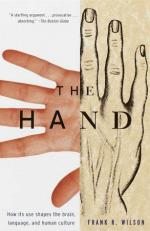
|
| Name: _________________________ | Period: ___________________ |
This test consists of 5 short answer questions, 10 short essay questions, and 1 (of 3) essay topics.
Short Answer Questions
1. What does the author attempt to do that is not a well-orchestrated pattern of learning from simple to more complex?
2. According to Wilson, what did the expansion of territory by hominids require?
3. What is pad-to-side?
4. What does Herophilus discover?
5. To what do marionettes exhibit similarities?
Short Essay Questions
1. What does Wilson propose as the juggling riddle, and why do children not aspire to juggle?
2. What do humans need to move out of the jungle?
3. How is the arm different from the leg in how it is attached to the body, and which parts of the upper body corresponds to the "folding crane"?
4. Who is George, and what does Wilson say about him?
5. What has to happen in order for the thumb to be useful?
6. What does the addition and transport of weight to the body cause?
7. Who is Robin Dunbar and what does he propose?
8. How did Duchenne demonstrate the physiology of movement?
9. What terms does John Napier use that mean essentially the same as "prehensile" and "non-prehensile" and what do the terms mean?
10. How does the touch of the pianist differ from that of the rock climber?
Essay Topics
Write an essay for ONE of the following topics:
Essay Topic 1
Discuss the following:
1. A puzzling consideration for the author is the hand's ability to be adept at rock-climbing and piano-playing. What do you think is meant by this statement? Use examples from The Hand to support your answer.
2. The human hand is a tool that functions at a wide variety and range of speed and strength. Use examples from the text to support your answer.
3. The hand function clinician John Napier identifies the terms "power grip" and "precision grip" by defining "prehensile" and "non-prehensile" movement. Explain the terms in the above sentence. Use examples from the text to support your answer.
Essay Topic 2
The Hand belongs to the non-fiction genre. Discuss the following:
1. Define the literary term "genre" and give several examples of three other genres in addition to the non-fiction genre.
2. Discuss two reasons why it might be useful to label a text by genre and two reasons it might be disadvantageous to label a text by genre.
3. What do you think is the difference between a non-fiction and a novel?
Essay Topic 3
The human brain accounts for intelligence or the ability to discover, weigh and relate facts to solve problems. Wilson claims there are two problem-solving strategies that stand out. They are the ability to design and manufacture a large, diverse, specialized inventory of tools and the use of words established by agreement among people as codes and symbols to stand for a real-world object or process.
1. Explain, in depth, why the ability to discover, weigh, and relate facts is a good measure of intelligence. Use examples from the text to support your answer.
2. Explain why the ability to design and manufacture tools is an important survival skill and problem solving ability. Use examples from the text to support your answer.
3. Explain how language consists of agreements about codes and symbols among people. Use examples from the text to support your answer.
|
This section contains 1,034 words (approx. 4 pages at 300 words per page) |

|




